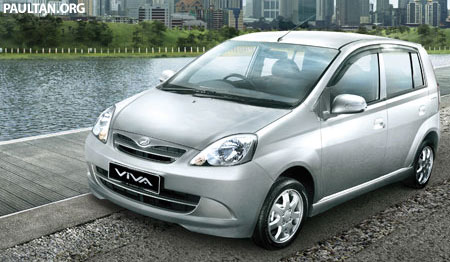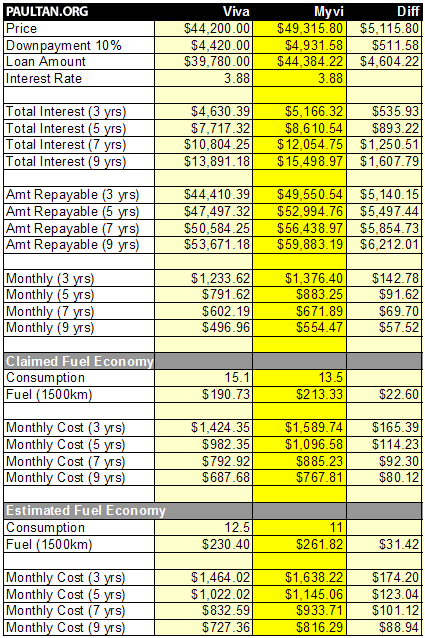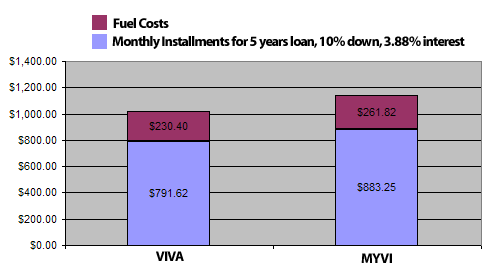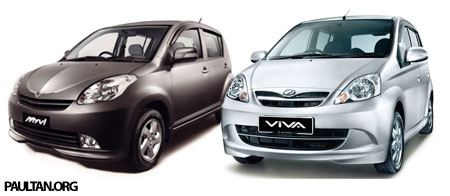Perodua Viva and Perodua Myvi Loan Comparison

We can assume if you buy a Perodua, you’re most likely going to be a very price-sensitive person. If you haven’t read my previous comparison of the Perodua Myvi and Perodua Viva, please click here to read it first. This blog entry focuses on the financial details if you buy a Perodua Viva or a Perodua Myvi.
First, we look at how much the car would cost in monthly repayments over a period of 3, 5 or 7 years assuming a 10% downpayment and 3.88% interest rate. The two variants of the Viva and Myvi I am using here are the Perodua Viva 1000cc Premium with Airbags and ABS, and the Perodua Myvi 1.3 liter Premium with Airbags and ABS. Both are of the automatic transmission variant with metallic paint.

First, let’s look at how much the two cars cost monthly. Over a 5-year loan which is what most people would take, the difference in monthly repayment between the Viva and the Myvi is about RM91.62 a month, or RM1099.44 a year. Over a 7-year loan, it is RM69.70 a month - or RM836.40 a year. If you think of it in monthly terms, an extra RM91.62 a month gets you an upgrade from A-segment to B-segment, more interior width so the rear bench is more comfortable with 3 people seated, and a smoother 4-cylinder engine that makes more power, together with a better power to weight ratio.
But let’s not forget what upgrading to a bigger 1.3 liter 4-cylinder engine will do - increase your fuel consumption. For this one, it’s a little bit tricky. We’ve got two different km per liter figures to play with - Perodua’s optimum situation claims as well as estimated real life scenarios for the Viva, as well as the average reported fuel consumption for the Myvi from the Myvi owners I’ve asked. We also assume a traveling distance of 1500km a month (50km to and fro work daily, times 30 to factor for other misc traveling during weekdays and weekends), and the current RON97 petrol price of RM1.92 per liter.
Using the optimum fuel consumption calculation - you’ll save RM22.60 a month driving the Viva compared to driving a Perodua Myvi. Using the estimated real life scenario fuel consumption calculation, you’ll save RM31.42 a month. This brings the the amount you have to fork out every month for a Viva to RM1,022.02 a month inclusive of 5-year loan monthly installment and fuel expenditure, and for the Myvi - RM1,145.06. Damn, even though these are supposed to be affordable, these cars are looking pretty expensive to run now. The difference between the Myvi and Viva for a 5-year loan in this case is RM123.04, or RM1476.48 a year.
This is of course, a calculation for the first year where your road tax and insurance premium has already been covered in the purchase price. But let’s just keep things simple for the moment. The Myvi has a higher insured value and a larger engine, thus the two items will be more expensive, further widening that RM123.04 gap but it won’t be too big a difference. In terms of percentage, it’s about a 12 percent difference.

What’s RM123.04, or a savings of 12 percent worth to you? Is it worth the upgrade from the Viva to a Myvi? I’m not here to decide for you, just presenting to you the figures so you can decide for yourself.
Related Posts:
Perodua Myvi vs Perodua Viva - Equipment and Specs Comparison
New Perodua Viva Full Details, Photos and Price!
Perodua Myvi vs Perodua Viva

I know some of you who are thinking of buying the Perodua Myvi are now considering buying the top of the range Perodua Viva 1000cc Premium instead. So I’m going to do a little comparison here. If you have anything to add, please feel free to comment and contribute to the discussion.
Power
Interestingly, it seems that the same 1.0 liter DVVT EJ-VE engine in the Perodua Viva makes more torque than the Perodua Myvi’s 1.0 liter DVVT EJ-VE engine. The Viva claims to make 90Nm of torque at 3,600rpm, while the Myvi 1.0 liter only makes 88Nm at 3,600rpm - that’s a minor difference of only 2Nm though.
Since the Perodua Viva 1.0 liter would clearly beat the Myvi 1.0 in terms of power to weight ratio, so let’s compare the Myvi 1.3 to the Viva 1.0 Premium instead. The Myvi 1.3 weighs 955kg and puts out 86 horsepower. That’s a power to weight ratio of 0.09 horsepower per kg. As for the Perodua Viva 1000cc Premium, it weighs 800kg and puts out 60 horsepower - that gives it a power to weight ratio of 0.075 horsepower per kg.
So we can conclude that in a drag race, the Viva won’t be able to smoke it’s larger sibling in stock form. That doesn’t mean the Viva is terribly slow - in a previous supermini shootout done together with folks at NST Life & Times, I found that the Myvi effortlessly smoked other superminis with larger 1.5 liter engines.
Another thing to point out is the Perodua Myvi 1.3 liter uses a 4-cylinder engine, and 4-cylinder engines are alot smoother than 3-cylinder engines like the one found in the Perodua Viva. 3-cylinders have more vibration, which might end up being felt by you in the steering wheel and other points in the chassis.
Fuel Economy
According to Perodua’s own charts, the Perodua Viva 1000cc Premium can travel 17.5km per liter of petrol on a combined cycle which I suspect involves alot of light footed driving and highway cruising. This is for the manual transmission. The Myvi 1.3 manual is rated at 17.1km per liter of petrol. Very similar fuel consumption, however the people on the streets who actually own the Myvi 1.3 manual reports actual mileage of about 13 to 14 km per liter if driven frugally.
As for the auto transmission, Perodua says the Myvi 1.3 Auto can get 13.5 km per liter, however the average man on the street usually gets about 10 to 11 km per liter. Comparing it to the Viva 1.0 liter automatic, Perodua says it can get 15.1km per liter, so expect about 12km per liter in reality.
Thus we can assume the Viva automatic should be a little more frugal than the Perodua Myvi automatic, but for the manual transmission models actual fuel economy should prove to be about the same.
Space
The Perodua Viva is actually longer in the interior than the Perodua Myvi at 1845mm compared to the Perodua Myvis 1835mm, but a great margin narrower. Having a long interior is important, it ensures the rear passenger legroom is at comfortable levels, just like the Perodua Myvi’s. However, being narrower the downside is you can’t really fit 3 people in the rear bench comfortably, making the Perodua Viva more of a 4-seater than a 5-seater. The Viva’s boot is only 149 liters with the rear bench upright compared to the Myvi’s 255 liters, significantly smaller, however you can extend this size by dropping the rear passenger bench to create a 449 liter space.
Ride and Handling
Nothing much can be said about the Perodua Myvi’s handling abilities other than the fact that it’ll probably get you to work and back safely. From what I’ve heard from some journalists who’ve driven the car, I think I shouldn’t expect much of the Viva’s either. Which is a shame as the Kelisa was a somewhat fun drive. Many will miss the Kelisa’s zippy DNA which is reportedly missing in the new Viva. If you want a driver’s small car, go get the Proton Savvy.
Equipment levels
One thing I am concerned about is the lack of an integrated CD player head unit in the Perodua Viva, which means Viva owners will have to be careful about where they park their cars lest their mirrors get smashed and their head units stolen. However, this means the CD player can be easily swapped.
The equipment level of the Perodua Viva 1.0 liter standard is disappointing to be honest, not even proper alloy wheels are supplied, instead you are given steel wheels. This means a difference of roughly RM4k on average gets you airbags, ABS, proper alloy wheels, wing mirrors with signal lamps, roof spoiler, and etc. I’m really not sure if it’s worth it or not - I’ll leave it up to you.
The Perodua Myvi on the other hand has just about everything you need in the baseline 1.3 liter model. It also feels more premium because of an interior design that looks abit more higher grade, as well as Optitron-style meters which are self illuminating, unlike the backlit meter clusters of the Perodua Viva.
Safety
Both the Viva Premium and Myvi Premium have dual airbags, antilock brakes - the usual stuff. The Perodua Myvi’s Japanese cousin the 2005 Daihatsu Sirion scored a 4 star score in the Euro NCAP crash test for adult protection, while crash test results of the previous gen Daihatsu Mira that the Perodua Viva is based managed a 3 star rating.
Price
Perodua Viva 1000cc MT Solid: RM36,800
Perodua Viva 1000cc MT Metallic: RM37,200
Perodua Viva 1000cc AT Solid: RM39,800
Perodua Viva 1000cc AT Metallic: RM40,200
Perodua Viva 1000cc Premium MT Solid: RM40,800
Perodua Viva 1000cc Premium MT Metallic: RM41,200
Perodua Viva 1000cc Premium AT Solid: RM43,800
Perodua Viva 1000cc Premium AT Metallic: RM44,200
Perodua Myvi 1300cc MT Solid: RM43,007.60
Perodua Myvi 1300cc MT Metallic: RM43,530.80
Perodua Myvi 1300cc AT Solid: RM45,912.60
Perodua Myvi 1300cc AT Metallic: RM46,435.80
Perodua Myvi 1300cc Premium MT Solid: RM45,912.60
Perodua Myvi 1300cc Premium MT Metallic: RM46,435.80
Perodua Myvi 1300cc Premium AT Solid: RM48,792.60
Perodua Myvi 1300cc Premium AT Metallic: RM49,315.80
The differences between the non-Premium and Premium versions of the Perodua Viva is roughly about RM4,000, while in the Myvi it is only about RM2,900 or so.
So yeah, Perodua Viva 1000cc Premium Auto Metallic at RM44,200 or the Perodua Myvi 1300cc Premium AT Metallic at RM49,315.80? That’s a difference of about RM5,000 there for a bigger engine, slightly more performance, a minor decrease in fuel consumption frugalness, a wider interior space, and a bigger boot.
The boot space doesn’t matter to me - both boots are too small for serious usage unless you put the rear bench seats down.
Is that extra RM5,000 to go from A-segment to B-segment worth it, or would you rather save the money?
Related Posts:
New Perodua Viva Full Details, Photos and Price
Perodua Viva and Perodua Myvi Loan Comparison
No comments:
Post a Comment